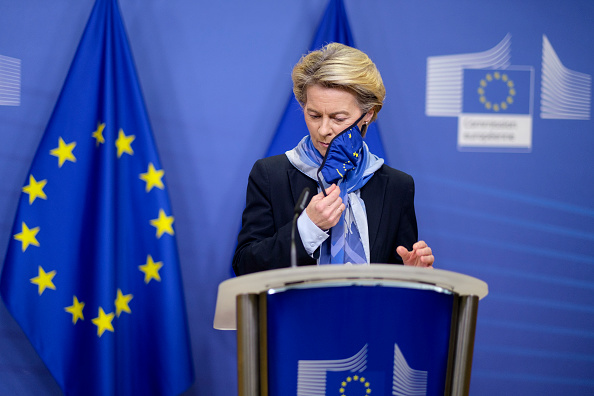One of the main planks of EU efforts to regulate the internet has always consisted of a commitment to take action against the “manipulative” and “inauthentic” online behaviours of “malicious actors”: For instance, involving the creation and use of fake accounts.
Thus, for example, Commitment 14 of the 2022 “strengthened” Code of Practice on Disinformation commits platform operators to “limit[ing] impermissible manipulative behaviours and practices across their services,” including:
– The creation and use of fake accounts, account takeovers and bot-driven amplification, …
and
– The creation and use of accounts that participate in coordinated inauthentic behaviour….
The Code has been integrated into the Digital Services Act (DSA), the EU’s signature legislation on online regulation, and similar warnings against “inauthentic” behaviour and fake accounts are also contained in the text proper of the DSA.
But recent revelations, as reported in Brussels Signal, that German intelligence is running hundreds of fake account on social media, raises an obvious question: What is this if not “manipulative” and “inauthentic” behaviour? And it is “coordinated” to boot.
Indeed, the hundreds of fake accounts are just the ones to which German authorities have officially admitted in response to parliamentary queries: 287 being run by the regional intelligence bureau of the state of Brandenburg, 236 by the Berlin intelligence bureau, and an unspecified number somewhere in the low hundreds by the state of Saxony.
But there are sixteen regional intelligence bureaus in Germany. If we use an estimate of, say, 250 fake accounts per bureau, that already gives 4,000 fake accounts. But this is to say nothing of the fake accounts being run directly by the federal bureau of Germany’s domestic intelligence agency, the Bundesamt für Verfassungsschutz (BfV). So, the real number of fake accounts being run by German domestic intelligence must be well into the thousands.
And what about Germany’s foreign intelligence agency, Bundesnachrichtendienst (BND)? The express purpose of the online operations of the BfV is to spy on Germany’s own citizens and residents, in the ostensible interest of combatting such threats as “right-wing extremism”, “left-wing extremism”, Islamism, and even “conspiracy theorising”. Per the 2022 report in Die Sueddeutsche Zeitung that first broke the story of the BfV’s use of fake accounts, the latter designation was explicitly meant to target, among others, domestic opponents of Germany’s notoriously strict Covid-response measures.
But, at least in countries that have traditionally had strong civil liberties protections like the US or the UK, domestic surveillance is subject to tight legal controls, whereas the general rule for foreign intelligence operations is essentially “no holds barred”.
Questions have been raised in Germany itself, for instance, about the X account of a certain “Lena Berger” or @lena4berger, a stridently pro-Ukraine “influencer” account that for a time enjoyed an effective reach wildly incommensurate with its relatively modest following. Despite having only 38,000 followers as of this writing, “Lena Berger”, posting in both German and English, would regularly achieve hundreds of thousands of views.
The German political scientist Johannes Varwick was troubled, however, by the apparent lack of evidence that the attractive young woman depicted in the profile picture really exists. At one point, he even offered a €500 reward for any such evidence: a misstep that, as reported in the German press, would earn him a criminal complaint for, in effect, incitement to doxxing. But Varwick was not calling for the doxxing — that is, exposing private information with malicious intent — of “Lena Berger”. He was suggesting that there is no Lena Berger to be doxxed, that the image of the young woman is AI-generated and that the account is run by, as he discreetly put it, an “intelligence milieu”.
If so, given Germany’s own massive support for and indeed investment in the Ukrainian war effort, then why not the BND?
We will presumably never know. Though, for what it’s worth, the account has gone largely silent since the controversy erupted.
What we do know, however, is that in the early days of the internet, before the emergence of social media, the BND was already hard at work finding ways to manipulate and exploit it. How do we know this? Well, thanks to none other than Wikileaks.
Unbeknownst to most of its contemporary fans, the original Wikileaks site went offline around the time of the publication of the “Collateral Murder” Iraq War video that would make the “Wikileaks” brand name famous. Perhaps the most explosive leak on the original site was of a document from Deutsche Telekom, the still largely publicly-owned German telecommunications giant, assigning IP addresses to the BND under a disguised domain name. Those IP addresses were found not only to be editing Wikipedia entries, but even to have been at the origin of a DoS attack against the American website Rantburg: a conservative blog/forum devoted to the “War on Terror”.
For more details on that story, see my “The Strange Career of Wikileaks” written in 2010 here.





How calling a German finance minister a ‘moron’ leads to cops and criminal charges